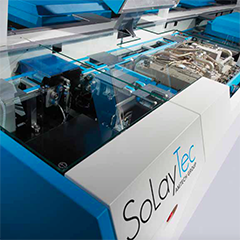It will not have escaped your attention that PERC is indeed setting the agenda right now. But to stay one step head, it’s worth ‘thinking smart, and choosing Spatial ALD’ argues SoLayTec’s Roger Görtzen in a typically passionate and well-considered piece.
In recent years, the p-type standard Al-BSF cells have improved significantly, especially with new front-end technologies such as new pastes for high ohmic emitters, double print and four busbars technology. With all these new developments for the front end, the time is ripe for the next generation of high-efficiency cells. It will be clear to everybody that following all these improvements for the front of the cell, it is the back of the p-type solar cell where the next efficiency gains can be achieved.
So, after years of development, since 2009, it cannot have slipped your attention that PERC is now hotter than ever. From 2008 until 2010, AlOx / PERC was dominated by R&D institutes at all major conferences around the globe. Since 2011 there have been only a few companies – Q CELLS, Gintech and Sunrise, among others – that started up PERC in pilot production (about ~1,200 wph). These companies were the pioneers and achieved efficiencies of about 18.3% on multi cSi.
After that Taiwanese and some European solar manufacturers started real mass production from 2013 as it seemed that market introduction was getting more and more successful. It was one of the ways for Taiwanese manufacturers especially to distinguish themselves from Chinese manufactures.
However, since last year Chinese solar manufacturers have also begun investing more effort in this technology and are expanding rapidly. Different Chinese solar manufacturers have already demonstrated great results with PERC. For instance, JA Solar announced 20.4% average on mono cSi PERC and Trina Solar achieved record efficiency of about 21.4% for PERC mono cSi material. It has become an undeniable fact: PERC is extremely hot these days
This year in total about 5 ~ 7 GW of PERC equipment installation will be finished and the total PERC installation for the complete market is about 7 ~ 9 GW. The ITRPV roadmap expects that the PERC market will double its current capacity in 2017, which means that PV PERC production capacity will reach about 16GW. The question is what kind of equipment can be used for PERC.
To date, PECVD Roth Rau has been the largest player, and the prediction is that it will install about 70-80 PERC machines in the coming months. The lead time for Roth Rau is already about nine months, if you are not a key customer. For key customers some exceptions can be made but, in general, the lead time counter is ticking further.


























